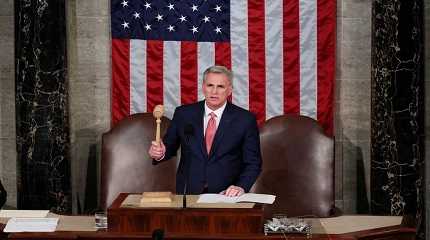
WASHINGTON, April 17 (Reuters) - Republican U.S. House Speaker Kevin McCarthy plans to make his case for cuts in federal spending to accompany a lifting of the government's $31.4 trillion debt ceiling in a speech at the New York Stock Exchange on Monday.
His speech comes as the federal government ticks closer to the moment sometime this summer when it will no longer be able to meet its financial obligations. Without action by the divided Congress, that would trigger a historic default that would shake the U.S. and world economies.
President Joe Biden's Democrats, who also control the Senate, have been at loggerheads with Republicans for months over next steps on the limit, with the White House insisting Congress lift the borrowing limit without conditions, as it did three times under Biden's Republican predecessor, Donald Trump.
McCarthy on Monday pushed back against Democratic arguments that his caucus was putting the U.S. economy in peril by refusing to act.
"Make no mistake: the longer President Biden waits to be sensible, to find agreement, the more likely it becomes that his administration will bumble into the first default in our nation’s history," McCarthy said on Twitter ahead of his speech, expected at 10 a.m. ET (1400 GMT).
The Republicans who control the House of Representatives this week will try to unify around a proposal that would lift the limit to May 2024 -- as the next presidential election campaign ramps up -- in exchange for sharp spending cuts. Such a proposal is unlikely to win the Democratic support it would need to take effect.
McCarthy leads a fractious caucus that holds a narrow 222-213 majority, including a sizeable contingent of hardline members who want sharp spending cuts and dismiss the risks of failure to act on the debt ceiling. So far House Republicans have not produced a proposed budget of their own, a move that Biden contends would be a necessary starting point for negotiations on spending.
"I don't know what we're negotiating. I don't know what they want," Biden told reporters on Saturday.
The White House last month proposed its own budget, which it said would cut the nation's deficit by nearly $3 trillion over 10 years, though it relied on increases in taxes on businesses and the wealthy, rather than spending cuts, to do so.
The nonpartisan Congressional Budget Office last month laid out a range of options to address the debt, which showed that higher tax collections would have significantly more impact than spending cuts.
LIST OF OPTIONS
Republicans have been discussing spending cuts for programs ranging from homeland security and law enforcement to health, education and environmental initiatives. This could be done by freezing spending at 2022 levels or allowing annual increases of just 1% for a decade, which would not keep up with inflation or population growth and thus effectively cut funding.
Such budgeting would not touch the main drivers of the debt Republicans complain about -- the Social Security and Medicare retirement and healthcare programs that are projected to nearly double in cost over the next 10 years, according to the CBO.
The closer Congress gets to the "X-date" when the federal government will no longer be able to pay its bills, the more nervous investors will become about the economic outlook. The last prolonged standoff over the debt ceiling, in 2011, led to a historic cut in the U.S. government's credit rating, which rattled markets and raised borrowing costs.
House Republicans are also mulling reforms to the debt ceiling, which has utterly failed at its intended purpose of restraining U.S. budget deficits.
Currently, the debt limit is statutorily set at a specific dollar amount -- now at $31.4 trillion -- though Congress sometimes suspends the limit, meaning it does not apply for a set period of time. House Republicans now say they are looking at indexing the limit to gross domestic product.




